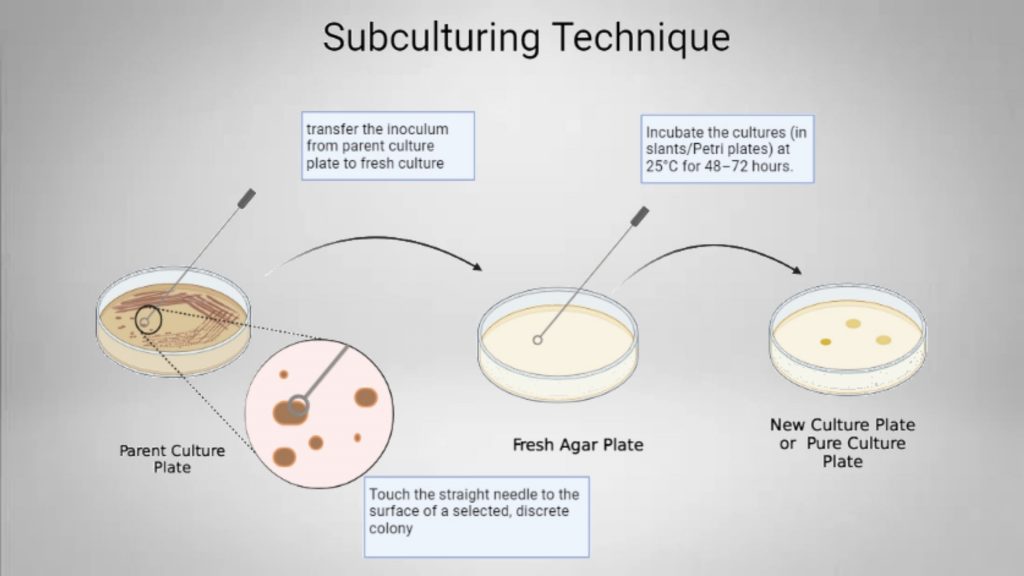Table of Contents
Overview of Subculturing Technique
In microbiology, subculture is defined as a new cell or microbiological culture, which is prepared by transferring a few or all cells to a fresh growth medium from an old culture or a previous culture.
In a single word, the transfer of cells from a previous culture to a fresh or new culture medium is known as subculturing.
Subculturing is also known as passaging or picking off technique. In the laboratory, this technique is used to increase the life and/or expand the number of cells or microorganisms in the culture.
Microbial cells can not be held in a culture medium for a long time due to the accumulation of toxic products and depletion of nutrients in medium.
As the cell number increases the accumulation of toxic product also increases and also the number of nutrients started to decrease, as a result, the bacterial cells enter the stationary phase, where proliferation is of cells reduced or ceased (the cell density value plateaus).
When the cells are transferred into a new or fresh culture medium nutrients accelerate the growth of the microorganism and it goes through the lag phase, where the cells are started to adapt to the new environment (here growth rate becomes slow). Then the cell enters into the log phase, a period where the cells grow exponentially.
Objective of Subculturing Technique
- To increase the life and/or expand the number of cells or microorganisms in the culture.
- To get the experience of the aseptic method in the field of Microbiology.
- To prevent contamination of cultures and media.
- To transfer cultures from one medium by inoculating another medium.
- To obtain pure culture from a mixed culture.
- To stop lab microorganisms from continuing to spread in the atmosphere and/or infecting the researcher.
Principle of Subculturing Technique
After incubation of streak plate, spread plate or pour plate, the separated colonies are examined, now the next step is to subculture some of the cells to a fresh medium (new agar plates or nutrient agar slants) with the help of a sterile needle or loop for further experiments.
Each of these new cultures represents the growth of a single species and is known as a pure or stock culture. The term subculturing is defined as the procedure of transferring microorganisms from their parent growth source to a fresh one pr from one medium to another.
When the cells are transferred to a fresh liquid medium (broth) from a solid medium (agar) is known as picking off.
Requirements
- Incubated Pour plate or Streak Plate or Spread Plate.
- Nutrient agar slants or nutrient agar plates.
- Inoculating loop
- Marking pencil.
- Microscope
NUTRIENT AGAR
| Ingredients | gl-1 |
| Peptic digest of animal tissue | 5.00 |
| Yeast Extract | 1.50 |
| Beef extract | 1.50 |
| Sodium chloride | 5.00 |
| Agar | 15.00 |
| Final pH (at 25°C) | 7.4 ± 0.2 |
Prepare Nutrient Agar Slant
- Nutrient agar slants can be prepared by mixing requisite amounts of the media ingredient with distilled water.
- Dissolved the agar by applying heat in a microwave oven.
- The loss of water due to evaporation was compensated and the medium was distributed as 10 ml aliquots in test tubes (18 x 150 mm), plugged with cotton.
- Autoclaved at 121°C for 20 min.
- After sterilization, the media was allowed to cool down to about 40-45°C, and the tube was then slanted on the working bench
Procedure of Subculturing Technique
- Label the agar slants and agar plates with the organism name by using the wax marking pencil.
- Sterilize the inoculating loop by holding it in the blue portion of the flame until it gets hot red. Allow the loop to cool for 30- 40 sec or cool it by dipping it in a fresh agar plate.
- Touch the tip of the loop to the surface of a selected discrete colony or the agar streak plate or the pour plate.
- Remove the plug of the agar slants, grasp the plug with the little finger of the hand and pass the neck of the tube rapidly over the Bunsen burner flame. Insert loop into the subculture tube and inoculate in by drawing it lightly over the hard surface in a straight or zig-zag line and recap the tube.
Or,
Lift the lid off the agar plate at 45°C and inoculate the plate in the center over the hardened agar surface and recap the lid of the Petri plate.
- The neck of the subculture tube is flamed and the cotton plug is reinserted.
- Following inoculation, the loop is again flamed to destroy the remaining organisms.
- Incubate the cultures (in slants/Petri plates) at 25°C for 48–72 hours.

Observation and Result
After incubation, observe the agar slants or plates for the growth of pure culture. Observe the colonies of cultured microorganisms.
Precautions
- Flame the lip of the tube during the insertion loop and during the withdraw of the loop.
- After flaming the loop never put down on the working table.
- Never touch the plug to anything; kept it in hand and never place it on the work surface.
- Flame the needle before performing the transfer of inoculum.
- Never leave the culture tube open.
Importance of Subculturing Technique
- It is an important laboratory technique for both proliferating (e.g. a microorganism like E. coli) and non-proliferating (e.g. terminally differentiated white blood cells) cells.
- This method used to produce a fresh culture with a lower content of microbial cells than the parent culture, fresh nutrients, and no toxic metabolites helps to continue the growth of the cells without risk of cell death.
- It can be used to prepare growth curve calculations (ex. generation time).
References
- Experiments in Microbiology, Plant Pathology and Biotechnology by K.R. Aneja
- https://vlab.amrita.edu/?sub=3&brch=73&sim=212&cnt=2
- https://www.iitg.ac.in/biotech/MTechLabProtocols/Expt-1%20(Culture-Transfer).pdf
